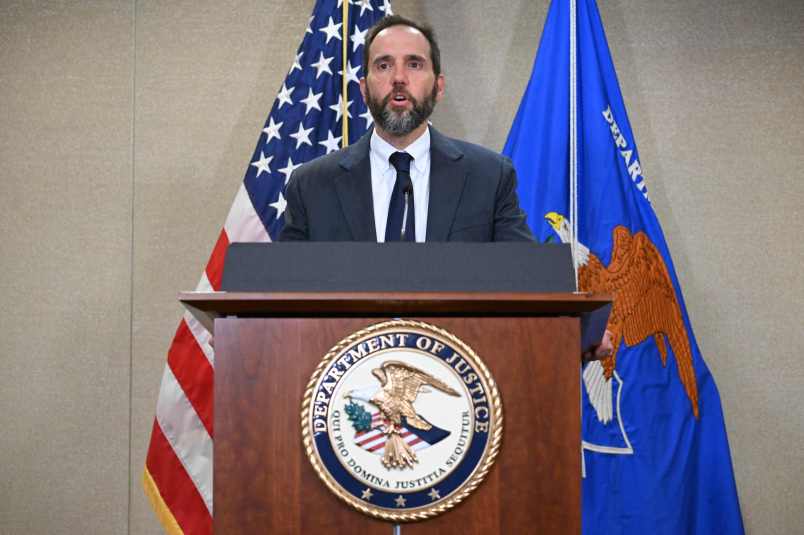It was one day after the 2020 election, and vote-counting in multiple key swing states was starting to speed up. The results weren’t looking good for Trump.
So, prosecutors with Special Counsel Jack Smith’s office said in a Tuesday filing, a Trump campaign employee worked to stage a riot at the main vote tallying center in Detroit, Michigan to block the count.
Prosecutors alleged that a Trump campaign staffer sought to create a mini-Brooks Brothers riot — or a mini-Jan. 6, whichever you prefer — at the counting facility in a filing outlining evidence related to the Trump charges that they plans to introduce at trial.
In the case of Detroit, Smith said that the campaign staffer “encouraged rioting and other methods of obstruction” in texts to a lawyer assisting the Trump campaign on Election Day. That came immediately after the staffer observed that the vote count was trending in Biden’s favor, Smith said.
Smith redacted the block of text that followed the allegation, but later described how a “large number of untrained individuals flooded” the center where votes were being counted. They then began to make “illegitimate and aggressive challenges to the vote count,” Smith said.
TPM extensively detailed this Detroit episode as an example of how focusing on the violence of Jan. 6 alone fails to capture the sweep and breadth of Trump’s coup attempt. Smith’s filing both reinforces that idea — that Jan. 6 was the violent culmination of a months-long effort to stay in power — but also evinces an understanding of Trump as a canny manipulator, reacting in real-time to events which he or his acolytes orchestrated.
In the case of Detroit, Smith writes, Trump followed up reports of the riot with “false claims” while it was his “agent” who was “seeking to cause a riot to disrupt the count.”
Smith said that the episode would allow him to demonstrate at trial that Trump and those working for him both knew they had lost the election and sought to interrupt the vote count.
It’s one example of violence directed at stopping an electoral function — in the case of Detroit, vote-counting — which Smith said he intends to introduce at trial. Smith said he would also introduce evidence showing Trump’s support in recent months for convicted Jan. 6 defendants, including Proud Boys leader Enrique Tarrio and scores of lower-level insurgents.
That, Smith said, would help show motive on the day of the Capitol insurrection; that Trump “sent supporters, including groups like the Proud Boys” as part of an effort to “achieve the criminal objective of obstructing the congressional certification.”
In some ways, the filing suggests, Smith appears to regard Trump’s attempt to block his 2020 loss as him running a premeditated playbook — one he would have put into action had he lost to Hillary Clinton in 2016.
Then, Trump baselessly claimed that voter fraud was rampant. Prosecutors even cite a 2012 tweet from Trump which presaged some of the more insane cyber-conspiracies that enveloped his team in late 2020; that Mitt Romney lost because voting machines had “switched votes,” prosecutors said, to Obama.
By 2016, Trump was a major party candidate. In a debate with Clinton, he refused to commit to the peaceful transfer of power. Instead, Trump replied, “I’ll keep you in suspense, okay?”
To Smith, that’s all of a piece with what he described as a wide-ranging “plan to undermine the integrity of the presidential transition process when faced with the possibility of an election result that he would not like.” It’s a depiction of the man that’s equal parts petty and grandiose, at once incapable of coping with defeat while armed with the means and vision to overturn the system instead.
That plot, Smith said, has also involved retaliation against those who criticize Trump or remind him that, in fact, he lost the 2020 election.
Smith accused Trump in the filing of working with his allies to suppress proof that his fraud claims were false, telling the story of an unnamed former chief counsel to the Republican National Committee who spoke up, and then faced retaliation from Trump and his allies.
In particular, prosecutors wrote that co-conspirator 1 — Rudy Giuliani — “took to Twitter to publicly attack” the person in the summer of 2021.
The only person who matches that description in Giuliani’s X, formerly known as Twitter, feed is Justin Riemer, a former RNC chief counsel. Giuliani called him an “anti-Trumper” for not cooperating with the 2020 coup attempt. The Washington Post ran a story the day after Giuliani’s tweet detailing how Riemer called election fraud arguments from Trump’s attorneys a “joke,” and subsequently faced efforts from Trump allies to have him fired.
Riemer didn’t return a request for comment from TPM.
That episode shows again that Trump and those around him knew that the fraud claims were false, Smith said; to keep up the charade, they had to “silence anyone who refuted their false claims.”







I vote for mini January 6.
The best way to start a riot in Detroit is to have one of their beloved teams win a championship.
He is already exhorting his followers to harass voters and those who count the votes in 2024.
Brooks Brothers Riot? I think Carhartt Commotion™ would be more apropos…
Jack Smith practices the law. Donnie, his lawyers, and his supporters practice prevaricating and nonsensical histrionics. We are a country of laws, not of grotesque blathering criminals.